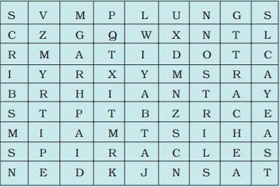Respiration in Organisms - Solutions
CBSE Class–VII Science
NCERT Solutions
CHAPTER-10
RESPIRATION IN ORGANISMS
Question 1. Why does an athlete breathe faster and deeper than usual after finishing the race?
Answer: During running the athlete uses up lot of energy. So, she/he needs more oxygen and it can be obtained by speeding up oxidation of food.This requires more oxygen to be supplied.This is the reason behind fast and deep breathing of athlete after finishing the race.
Question 2. List the similarities and differences between aerobic and anaerobic respiration.
Answer: Similarities-
(i) Energy is released.
(ii) Carbon dioxide is produced.
Differences-
(i) Anaerobic nutrition takes place in absence of oxygen but aerobic respiration needs oxygen.
(ii) Glucose is completely broken down in aerobic respiration while in anaerobic respiration incomplete oxidation occurs.
Question 3. Why do we often sneeze when we inhale a lot of dust-laden air?
Answer: The air around us has various types of unwanted particles, such as smoke, dust, pollen etc. when we inhale; the particles get trapped in the hair present in our nasal cavity. Sometimes these particles enter the nasal cavity and create irritation that leads to sneezing.
Question 4. Take three test-tubes. Fill 3/4th of each with water. Label them A,B, and C. Keep a snail in the test-tube A, a water plant in test tube B and in C keep snail and plant both. Which test-tube would have the highest concentration of CO2?
Answer: Test-tube A will have the highest concentration of CO2 because snail will take in oxygen and gives out CO2. In test-tubes B and C, the CO2 will be utilized by the water plant for Synthesizing food and hence there will be less concentration of CO2 in these.
Question 5. Tick the correct answer:
(a) In cockroaches, air enters the body through
(i) lungs
(ii) gills
(iii) spiracles
(iv) skin
(b) During heavy exercise, we get cramps in the legs due to the accumulation of
(i) Carbon dioxide
(ii) lactic acid
(iii) Alcohol
(iv) water
(c) Normal range of breathing rate per minute in an average adult person at rest is:
(i) 9-12
(ii) 15-18
(iii) 21-24
(iv) 30-33
(d) During exhalation, the ribs
(i) move outwards
(ii) move downwards
(iii) move upwards
(iv) do not move at all.
Answer: (a) (iii) Spiracles
(b) (ii) Lactic acid
(c) (ii) 15-18
(d) (ii) move downwards
Question 6. Match the items in Column I with those in Column II
Column I | Column II |
(a) Yeast | (i) Earthworm |
(b) Diaphragm | (ii) Gills |
(c) Skin | (iii) Alcohol |
(d) Leaves | (iv) Chest cavity |
(e) Fish | (v) Stomata |
(f) Frog | (vi) Tracheae |
Answer: (a) (iii) (b) (iv) (c) (i) (d) (v) (e) (ii) (f) (vi)
Question 7. Mark ‘T’ if the statement is true and ‘F’ if it is false:
(i) During heavy exercise the breathing rate of a person slows down.(T/F)
(ii) Plants carry out photosynthesis only during the day and respiration only at night. (T/F)
(iii) Frogs breathe through their skins as well as their lungs.(T/F)
(iv) The fishes have lungs for respiration.(T/F)
(v) The size of the chest cavity increases during inhalation.(T/F)
Answer: (i) F (ii) F (iii) T (iv) F (v)T.
Question 8. Given below is a square of letters in which are hidden different words related transpiration in organisms. These words may be present in any direction-upwards, downwards, or along the diagonals. Find the words for your respiratory system.
Clues about these words are given below the square.
(i) The air tubes of insects.
(ii) Skeletal structure surrounding chest cavity.
(iii) Muscular floor of chest cavity.
(iv) Tiny pores on the surface of leaf.
(v) Small opening on the sides of the body of an insect.
(vi) The respiratory organ of human beings.
(vii) The opening through which we inhale.
(viii) An anaerobic organism.
(ix) An organism with tracheal system
Answer: (i) The air tubes of insects – Trachea
(ii) Skeletal structures surrounding chest cavity – Ribs
(iii) Muscular floor of chest cavity – Diaphragm
(iv) Tiny pores on the surface of leaf – Stomata
(v) Small openings on the sides of the body of an insect – Spiracles
(vi) The respiratory organs of human beings – Lungs
(vii) The openings through which we inhale – Nostrils
(viii) An anaerobic organism – Yeast
(ix) An organism with tracheal system – Ant
Question 9. The mountaineers carry oxygen with them because------------.
(a) At an altitude of more than 5 km there is no air.
(b) The amount of air available to a person is less than that available on the ground.
(c) The temperature of air is higher than that on the ground.
(d) The pressure of air is higher than that on the ground.
Answer: (b) The amount of air amiable to a person is less than that available on the ground.


